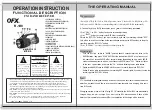
User Manual: Generic Section
Section: Introduction 0-4
Revision: 00
Page
11 of 21
Sonardyne Systems
Term
Definition
Long-Base-Line (LBL) System
A system where two or more transponders are on the seabed.
The positions of the transponders are established by a
calibration process in a seabed frame.
The distances from a transducer to each transponder are
measured using a transceiver.
The position of the transducer can be computed in the seabed
frame.
The name comes from the "baselines" joining each
transponder. It is can be to as a range-range system
Short-Base-Line (SBL) System
A system where three or more transducers are fixed to a vessel
and connected to a single transceiver.
The position of each transducer is measured and co-ordinated
in the vessel frame. By measuring the time of arrival of the
signal from a transceiver at each transducer the position of the
transceiver in the vessel frame can be computed.
Ultra-Short-Base-Line (USBL) System
A system similar to an SBL system except the system uses
three or more elements in a single transducer array.
The measurements it makes are the differences in "time-
phase" of the signals from each element.
The co-ordinate frame is fixed to the transducer array which
must be oriented in the vessel frame to be equivalent to the
SBL system.
Long-Ultra-Short-Base-Line (LUSBL)
system
A hybrid of an LBL and a USBL system. It utilises USBL
equipment in an LBL configuration.
Dual-Redundant LUSBL System
Two complete sets of LUSBL equipment working in tandem on
a master/slave basis.
The two sub-systems are cross-linked so that, in the event of a
failure of any major elements, system operation will continue
without the need for operator intervention.
Operation of the dual-redundant version is identical to that of
the standard version.
EHF
Extra-High Frequency (50-110kHz)
HF
High Frequency (35-55kHz)
LF
Low Frequency (7.5-15kHz)
LMF Low-Medium
Frequency
(13-17kHz)
MF
Medium Frequency (18-36kHz)
Sound Speed
If seawater is at a constant temperature, salinity and pressure
the speed at which sound travels in seawater is constant.
Sound speed can be derived from values of conductivity,
temperature and depth, or it can be measured directly using
time-of-flight instruments.
Содержание 8142-000-01
Страница 100: ......
















































